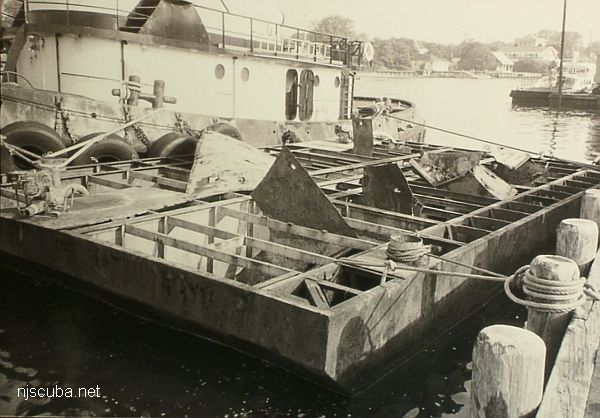Doing It Right?
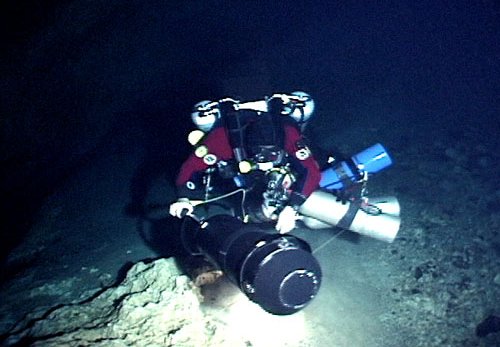
"DIR" or "Doing It Right" is a system of diving developed by cave divers which involves extremely rigid gear configurations and methodologies. To its adherents, DIR takes on an almost religious significance. For the true follower of DIR, no deviation may be tolerated, because DIR is perfection.

DIR is designed for cave diving. The usual object of cave diving is to go in and come back out alive. In line with this goal of accomplishing essentially nothing, DIR espouses an absolutely minimal equipment kit: "When in doubt, leave it home." DIR also espouses teamwork, mutual interdependence, and close lock-step buddy diving, things that are pretty much unavoidable in the confines of a cave anyway.
To spread their teachings, DIR adherents have developed the DIR-F course, or "DIR-Fundamentals". This is DIR for open-water divers and is marketed aggressively to beginning divers as advanced training. While many aspects of DIR make sense in a cave environment and are at least workable in open water, they are far from optimal in the ocean. This is especially true for North Atlantic ocean wreck diving, where many DIR concepts are flawed and even dangerous.
Cave divers, tropical reef divers, and even Great Lakes divers all have one thing in common: their diving is essentially no-touch. Apart from some photography perhaps, there is no goal other than to float through the underwater splendor ( or gloom, as the case may be ) and enjoy the view. In the North Atlantic, there often is no view. We dive for other reasons - hunting, fishing, and recovering artifacts that would otherwise be lost forever in the sea. On rare occasions, we can even attempt photography. A North Atlantic diver seldom enters the water without some goal in mind, some task to accomplish, and seldom leaves the water satisfied unless the job is done.
And for the North Atlantic diver, all this takes place under conditions that are far more difficult and unpredictable than most other divers will ever encounter. The single, unvarying minimalist gear configuration of DIR simply will not do, and its strong reliance on the buddy system quickly unravels in the wide-open spaces and low visibility. Northeast divers are a different breed - we're not what you learned about in your open-water manual.
Northeast wreck divers have developed their own ways of coping with the extreme conditions we face on every dive. These methods and configurations have been validated over decades of actual use. But we lack the organization, promotional skills, and business savvy of our cave-diving cousins. Just because we never made up a catchy name or a neat acronym ** for our way of doing things does not make it any less valid. Additionally, none of us would be so arrogant as to claim that open-water equipment and training would be appropriate for cave diving. Any reasonable person recognizes that different conditions require different means. DIR, on the other hand, is rigid, universal, and unrealistic.
** I propose "Diving Under H2O" or perhaps "Doing It Real." That's catchy.
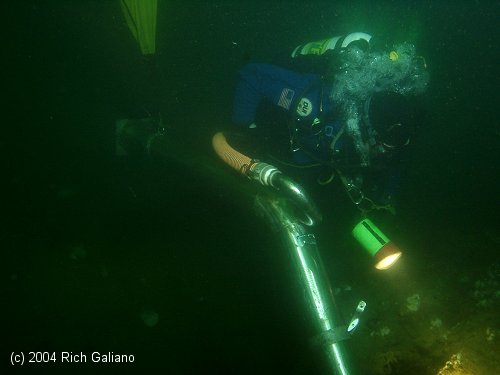
The equipment suggestions in this website are based on my own experience, built through many hundreds of northeast ocean dives with many of the best wreck divers in the world. These suggestions are not based on some three-day course ( although I've had a few of those as well ) or some improbable theory or imaginary fear. These are things that work. However, unlike a DIR fanatic, I'm not going to tell you that these are the only things that work. Every one of us does things a little bit differently, and it all works.
Cave divers assert that wreck penetration is the same as cave diving. There are similarities to be sure, but I would not say they are the same at all. For one thing, in the few places where it is possible, penetration is entirely optional for the wreck diver, whereas it is the cave diver's reason for being. That is hardly a good reason for a wreck diver to adopt a cave diver's equipment. Most wreck penetrations are nowhere near as long as a cave. While cave divers always operate in co-dependent buddy pairs, many of the best wreck divers prefer to do penetrations alone. Northeast divers do not rely on each other in emergencies, they rely on themselves. The reasoning is that a buddy is just another person to muck things up and be in the way; more likely to cause problems than solve them.
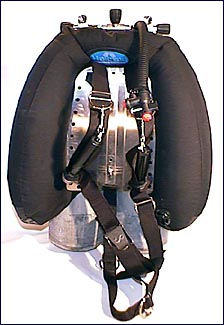
In many places in this website, you will find that I am not suggesting one thing, but a whole range of things from which you may decide. This is completely unlike DIR; in fact, it is the exact opposite. ( At right: the one and only proper DIR diving setup. ) As I go through various subjects, I will try to confirm, refute, or debunk the DIR system with regard to local diving conditions. Please bear in mind that I am not talking about DIR in caves, I am talking about DIR out here in the real world. DIR adherents will counter that DIR applies everywhere. I will allow that an impure form of it can be made to work outside of a cave, but it is not necessary, and far from optimal.
My goal in explaining dive gear is to give the beginning diver some insight into things that are beyond what is covered in most entry-level diving courses. Read these pages, but develop and use your own judgment. The beginning diver should go slow, observe as much as possible, seek advice and training from real experts, and find what works for you. Above all, think for yourself.

DIR is a poor form of advanced training for inexperienced divers. Unfortunately, many of the people who take DIR-F classes are so naive as divers that they end up being completely taken in by what they are presented. Beginners lack the experience by which to critically evaluate what they are taught in such a class. They come away with a sense of awe for cave divers, and a dangerously undeserved confidence in their new diving "skills." Organizations like TDI offer much better alternatives to DIR-F, unless you specifically want to become a cave diver.
Of course, the best teacher of all is Mr. Experience, but you can't write him a check for a convenient three-day course and a C-card.
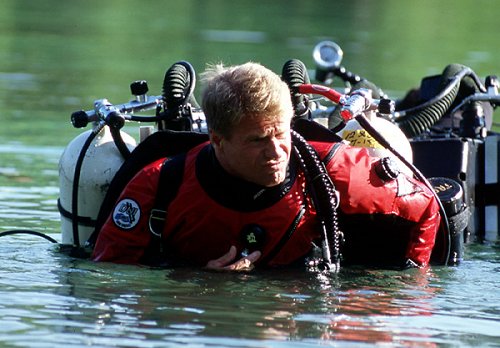
His rig appears to be two sets of large doubles, on either side of a rebreather, with a bulky battery canister mounted on one side. The all-up weight of all this hardware must be over 250 pounds. I imagine it can only be assembled and donned in the water. This might be ok for scootering down a cave, but it would never work in the open sea. Also note the flimsy trilaminate drysuit.
Note to Cave Divers:
From time to time, these pages draw flak from the cave diving community. Unless you have dived here and experienced our conditions, you have no more right or credibility to criticize me than I have to criticize whatever it is that you do in your caves. ( I have no interest in cave diving. )
Cavers are the self-appointed epitome of all divers. Understand though, that here in the Northeast, many of us do not agree with you on that. To tell the truth, among the real giants of Northeast wreck diving ( among whom I do not count myself, but count myself fortunate to be able to learn from, ) I have encountered little but scorn and ridicule for the DIR method, and cave diving in general. I will try to refrain from that.
Previously, this website took a sarcastic tone toward DIR which was born of years of annoyance with all the hype and over-stated claims of cave-diving. Henceforth I will try to refrain from that as well. This page in particular has been re-written several times to that end.
I have been told I need be more "open minded" about DIR. This is ironic since DIR is the most closed-minded subject I have ever encountered. Instead, why don't you
Oddly, many of my most vocal critics are "90-day wonders", with little more than one season of warm-water dives and a DIR-F class to their credit. If you fit this description, take your fingers off the keyboard right now before you embarrass yourself.
On DIR and Other Religious Subjects ( a joke )
Warning: Politically Incorrect
I converted to DIR ( "Doing It Right" ) about 6 months ago and I have found that the philosophy extends way beyond diving. I think most people tend to view DIR as a gear configuration or diving objective type of thing but it really is a philosophy that you can use in other parts of your life. For instance, below are just some of the ways I've extended the DIR way of doing things into other areas of my life.
Last week some of my buddies came over to my house. Now, not all of them are divers but they do understand the DIR philosophy. So, first off, we all drink the same beer. This avoids any situations where you might be enjoying a lager and accidentally pick up an ale ( or the other way around. ) That can be very uncool. That could quickly lead to a panic situation so we avoid it all together. We also drink only from cans, not bottles. And we never put the beer in the refrigerator. It always goes in the ice chest in my living room. 47% of Drinking Related Incidents (DRI ) occur when someone is going to the fridge for another beer, so better to be safe than sorry. Of course, this is all rigged up while we're still 100% sober so there's no impaired judgment once things get cooking.
All of us wear a bungie necklace with a full beer on it just in case someone experiences an Out Of Beer ( OOB ) emergency. I can offer my already opened beer to my buddy and simply reach down and grab the backup off my beer necklace. And, without exception, we always use the 7-foot hose on the beer bong.
Of course, we don't stay in every night, so when we do decide to go out we make sure we're still DIR. All of us wear exactly the same clothing:
- Levi's 501 Jeans, black ( button hole, straight leg )
- Gap Black T-shirt
- Haynes boxer shorts, black
- Gold Toe socks, black
- Kenneth Cole shoes, Brad Bitt style, black
- G-Shock watch, black band
- Nylon belt, black, with military buckle
- Black Leather Jacket ( optional, depending on weather conditions )
This may sound a bit silly or overdone but believe me, when you're penetrating a night club, knowing exactly what you buddies are dressed like can make all the difference in the world if you're hoping to snag some hottie. Let's say I see some cutie and just before I get up to go talk to her a waitress spills a drink in my lap? No problem, because I can always swap pants with my buddy. I don't have to worry if they match, because I know he's wearing Levi's 501's. Bam! Swap pants and I can still complete my objective.
One thing to keep in mind about nightclubs is that you seldom want to penetrate a club on beer. I know, some of the macho jerks do this and brag to all of their buddies. Believe me, it's not DIR. You have to do it on mixed drinks. Obviously the mix will be different on different nights but a good vodka tonic mix is pretty standard. Again, there's a right way and a wrong way to do this. You can't just order any old vodka or depend on some bartender to get the mix right. That's what the strokes do. No, you order Stoli vodka, which has an excellent reputation in the DIR partying community. The correct blend is 2oz Stoli with tonic water poured over ice in a highball glass ( lemon or lime optional. ) I always bring a testing kit with me and if the blend is off, I send it back. It's just not worth the risk and it's not DIR.
So you penetrate the nightclub and you've got a good mix, now it's time to meet the ladies. I should have said this earlier but watch your drink consumption. It's a well-known fact that women look 25% - 30% better in a nightclub and if you get all narced up on vodka tonic, it increases your chances of a coyote ugly blackout. You have to keep your wits about you.
If it's early, you probably have pretty good viz. Later in the evening when the smoke silts up the room it'll be harder to make out the women on the other side of the club so get your headings early. On a few occasions I've had to bust out the wreck reel just to get to the bathroom and back.
If you are lucky enough to hook up with a nice hottie, this is when doing it right really can pay off. Now, let's face it, there's a certain degree of danger involved here that I don't want to downplay. You need to minimize your risks by using the proper equipment. I carry 2 condoms. One I put on my - well you know, and the second I put on a bungee that goes around my waist. If there's a malfunction on my primary, I can quickly go to my backup without skipping a beat.
So, as you can see from these pretty basic examples, DIR is not just for diving. It's something you can use in all areas of your life.
Keep it real.
( Edited for kids. )
Editor's note:
This essay was originally an anonymous posting to a scuba newsgroup. I did not write it. It is meant to be humorous. DIRFers, you do remember what that is, don't you? So let's not send any more nasty emails, ok? And a few weeks ago, several buddy teams from the local WKKKP chapter showed up in their black hoods and burned a wetsuit on my front lawn, chanting "Stroke! Stroke!" until I turned the garden hose on them. Really, such hooliganism is unacceptable. It gives cave diving a bad name and left a big dead spot in the grass.
Strange as it may seem, no amount of learning can cure stupidity, and formal education positively fortifies it.
-- Stephen Vizinczey, Hungarian writer

